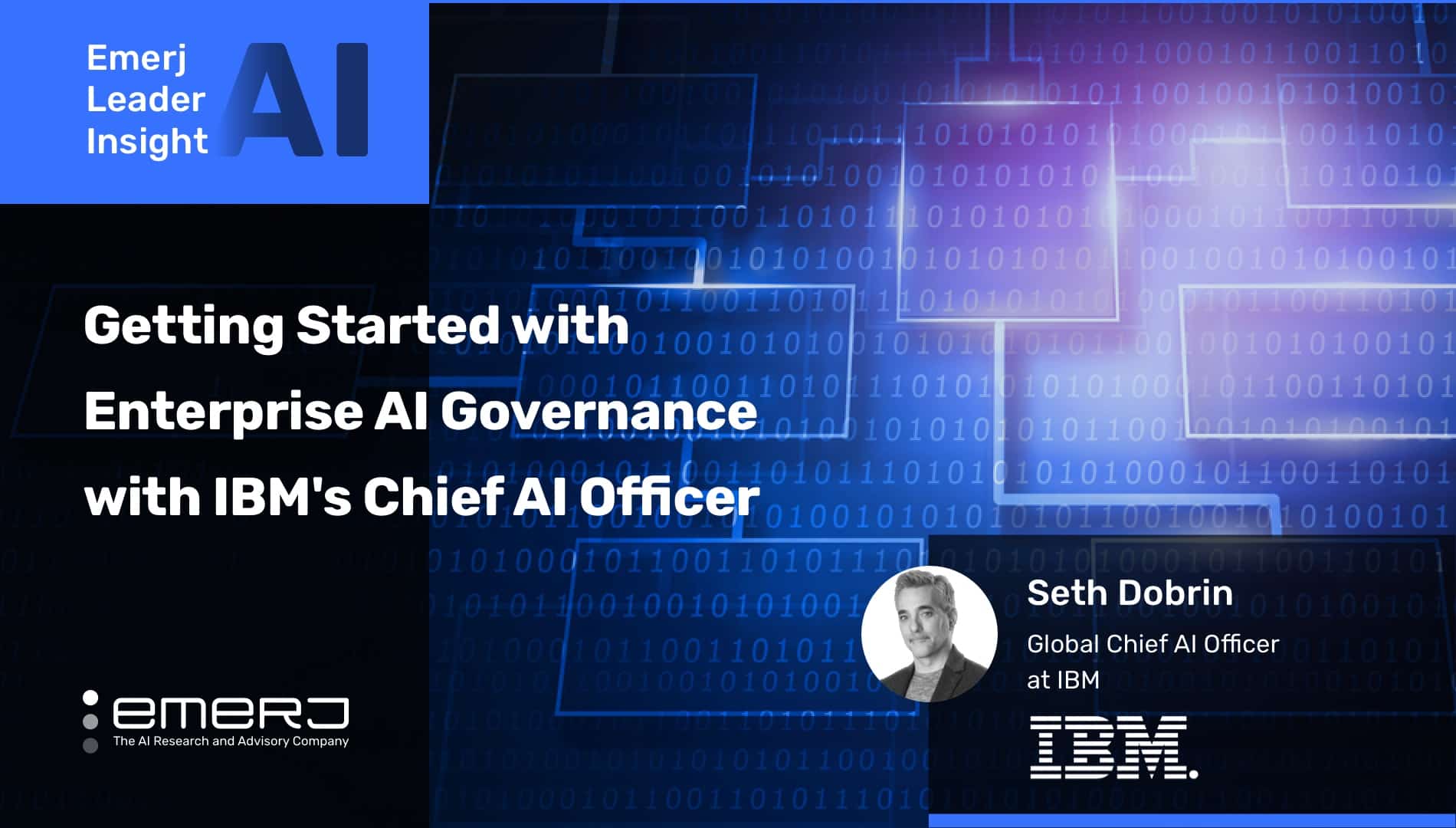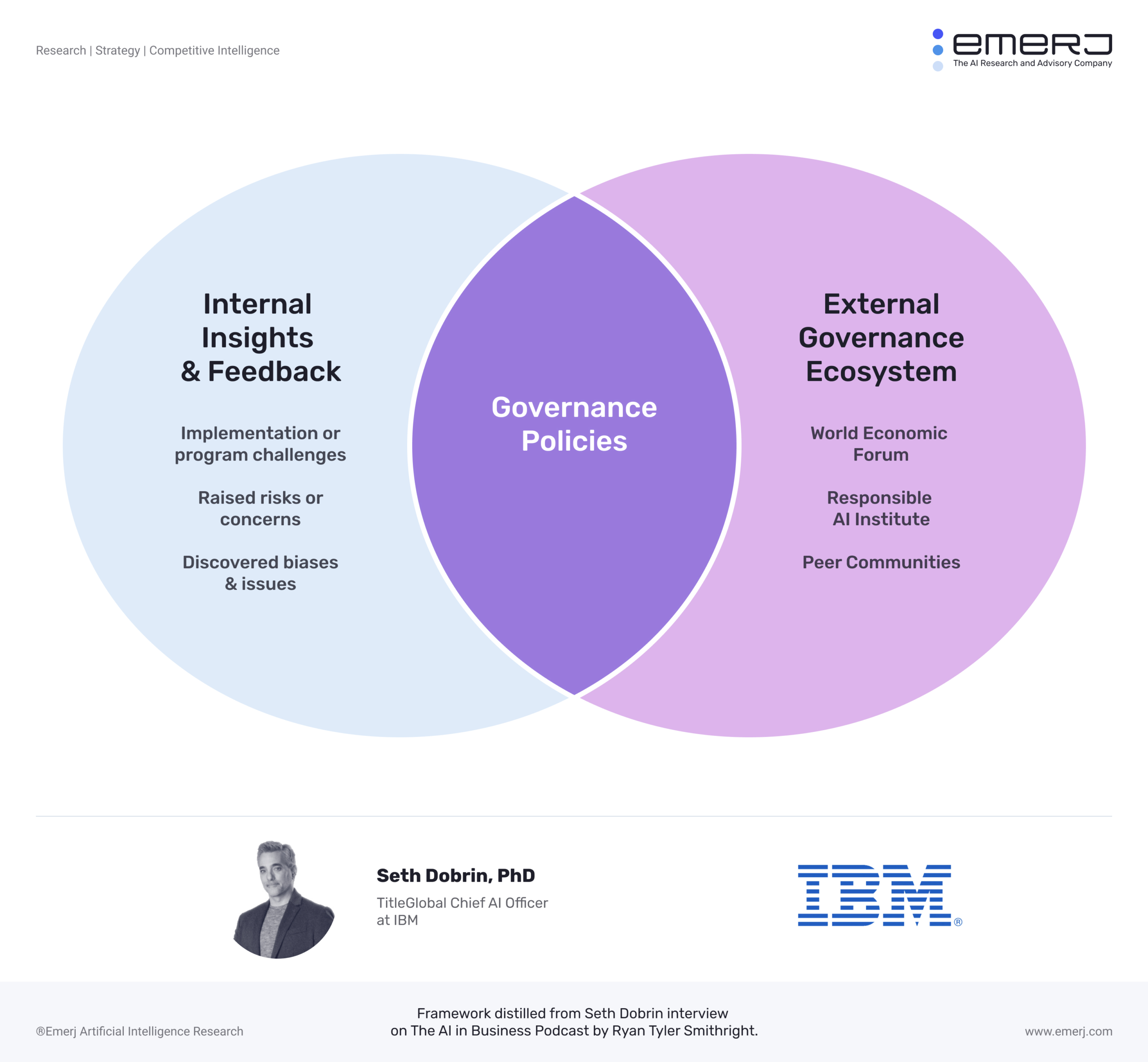
This article has been sponsored by IBM, and was written, edited, and published in alignment with Emerj’s sponsored content guidelines.
When we bring up the concept of governance in the workplace, people begin to envision roadblocks, delays, and bureaucracy. But when governance is done right, it is no longer a roadblock, but an enabler, a tool that we can use to accelerate transformation. AI governance empowers our organizations to move with agility, transparency, and trust as we implement AI. Rather than slowing us down, AI governance enables us to define policies, establish accountability, and integrate digital transformation within our enterprises.
Done right, AI governance grants us visibility into what we should and shouldn’t do as we look to the role of AI in the future of our organizations.
In December, Emerj’s Dan Faggella sat down with Dr. Seth Dobrin. He is IBM’s Global Chief AI Officer and an OpenGroup-Certified Thought Leader in Data Science. Dr. Dobrin holds a PhD from Arizona State University and has a background in AI, analytics, and cloud and cognitive software.
IBM provides integrated solutions and products that leverage data, information technology, and its expertise across a broad ecosystem of partners and alliances. IBM’s hybrid cloud platform and AI technology and service capabilities support their clients’ digital transformations and draw from the experience and expertise of a globally recognized research organization. IBM generated $73.6 billion in revenue for the year ended December 31, 2020, according to its 10-K.
In this 25-minute interview, we cover three distinct topics:
- What is Enterprise AI Governance?
- Why is it valuable?
- What steps should you consider taking?
Listen to the full episode below or read this article for key insights and a guide to getting started with Enterprise AI Governance.
Guest: Seth Dobrin, PhD, Global Chief AI Officer at IBM
Expertise: Transforming businesses via data science, information technology, automation, and molecular techniques
Brief Recognition: Before becoming IBM’s Global Chief AI Officer in February 2021, Dr. Dobrin held various positions of increasing importance within IBM, including Chief Data Officer, IBM Cloud and Cognitive Software; and Vice President and Chief Data Officer, IBM Analytics. Earlier in his career, he served as the Director of Digital Strategies for Monsanto Company and the Director of the Center of Medical Genetics at Marshfield Clinic. Dr. Dobrin holds a PhD in Molecular and Cellular Biology from Arizona State University.
In addition to his role as Global Chief AI Officer at IBM, Dr. Dobrin serves on advisory boards for the Responsible AI Institute, WLDA, and Baruch College, and as a brain trust member for XPRIZE and Protocol.
Key Insights
- The Definition of AI Governance – Effective AI governance communicates the scope and value of your organization’s AI capabilities to department leaders, answering the ‘how,’ ‘when,’ and ‘why’ of implementing AI. It installs ‘guardrails’ that make clear what should and should not be out-of-bounds. And, it provides integrated tools and clear processes for support and accountability, both during and after solution development.
- The Value of AI Governance – Good AI Governance accelerates digital transformation. It empowers teams to implement and operate more efficiently, with increased:
- Agility
- Velocity
- Transparency
- Trust
A Guide to Getting Started with Enterprise AI Governance
“It’s really hard for me to tell someone how to do [AI Governance]. It’s more of … help them figure out how to do it… The best way to learn is to do.”
The quote above comes from the end of the interview. Beginning with the end in mind – and taking Dr. Dobrin’s advice – we designed this guide to support the start of your journey with a set of powerful questions. It offers suggestions, not prescriptions. Take your time as you consider these questions.
How to use this guide:
- Answer the guide’s questions honestly, and
☐ Write down your answers.
☐ Print out the guide. Don’t put it on your desk; put it where you keep your lunch.
☐ Bring it to lunches with your colleagues, and honor them by requesting their genius.
☐ Consider the worst thing that could happen if you keep these ideas to yourself.
☐ Change your mind about something. Can you? Are you brave enough to be wrong?
☐ Don’t keep your genius to yourself! Share your best ideas and insights with the Emerj community, with your internal interest groups, even with Reddit.
- Rethink governance. Rather than visualize governance at the top of your strategic framework, consider it as a stable and supportive foundation.
This is not set in stone, and this guide isn’t a Bible. Rather, it represents how I think of governance as I work through the guide. A healthy AI Governance Framework is a living one, stewarded by our community. It’s mine. And it’s yours.
☐ Think back to this positioning of governance as you answer questions.
☐ Sketch out how governance fits into the strategic layers of your organization.
☐ Don’t be timid about scratching some things out later, if needed.
☐ Do you have some great ideas that could help expand or improve this framework? What do you think? Post your best idea: #ai-governance
As you move from AI experiments and proofs-of-concept into powering critical parts of your enterprise, ask these questions:
Step 1 – Structure Leadership
What skills, traits, and experience should our AI Governance leaders have?
[Suggestion: Ensure your governance roles contain a balance of business and technical expertise sufficient to clearly structure the requirements of your AI Governance framework and ML Ops processes]
How will we identify, train, and empower AI Governance leaders for our organization?
[Suggestion: Consider engaging internal and external industry leaders to seed your advisory board. Consider investing in a program to begin enhancing “Executive AI Fluency” for your organization’s leadership.]
Given our unique solutions, features, and culture, what AI Governance structure will be most effective for our organization?
[For example: IBM showed leadership by establishing an AI Ethics Board and shares its actions publicly.]

Step 2 – Determine Principles & Policies
What principles and policies should guide my organization’s AI governance?
[Suggestions:
- Learn from the shared experiences and best practices of market leaders.
IBM shares its AI processes and tools publicly via the World Economic Forum, the Responsible AI Institute, and other open-source forums, and makes money via services and implementation.
- Formalize an ethical framework to establish ‘guard-rails.’
Establish where to play and what is officially ‘out of bounds.’
For example, IBM has decided not to participate in any facial recognition.
- Provide transparency while still maintaining fiduciary responsibility.
- ‘Precision Regulation’ can start with principles and evolve to address the emergent particular cases faced in your organization.]
How defensible is our position if we make a mistake?
[Suggestion: When issues arise, be transparent. And make transparency easy. ‘Here’s our process. Here’s what we’ve done.’]
How can we address the potential risks associated with model biases?
[Suggestion: Consider your primary use cases first. Then match policies to processes.
For example: An organization might want different governance processes for monitoring biases in a credit application scoring model than for a product recommendation engine.]
“When done right, [governance] turns from being a roadblock into being an enabler, a way for you to accelerate your transformation.”
Step 2.5 – Communicate Value (to support Change Management)
How can I proactively address fears that new governance will put up roadblocks?
[Suggestion: Communicate the benefits of more clarity, support, reduced risks, and increased implementation velocity for your new tech!]
How will we engage our leaders to form supportive governance to communicate the value and capabilities enhanced by the initiative?
[Suggestion: Lead with business value whenever possible.]
When do we start?
[Suggestion: You don’t need perfect governance before you get started. Work to engage your leaders, and support improvements over time.]
HOW do we start?
[Suggestion: Start the conversation with Data Governance. The need for organized and ethically sourced data is often clear, and it leads naturally to discussions about how the data will be used.]
“What is the general-purpose technology that you can use in order to assess – in context – the privacy, the robustness, the fairness, the explainability, and have the level of transparency that you need?”
Step 3 – Implement Supportive Technology
How do I provide governance to support the tools & technologies we already have?
[Suggestion: You don’t need to replace everything! A good governance solution can work with and around what you already have.]
What general-purpose technology can be used to assess these critical features?
Privacy
Model Robustness
Fairness
Explainability
Transparency
How can we integrate governance to support our AI Lifecycle Management processes?
[Suggestion: Can we establish a common AI governance checklist to use during project selection? Do we have reference-able tools that our data science of functional leaders can use to make governance decisions quickly?]
Step 4 – Monitor & Maintain Models
How will we monitor the changing results of each model over time?
Consider monitoring models for:
- Performance
- Robustness
- Fairness
How, and how often, should we check our models for bias?
Biases to watch for:
- Age
- Gender
- Racial
- Ethnic
- Religious
What other potential biases could arise for our use cases?
[Suggestion: If so, are there data we might exclude entirely, or replace with data that lacks the same bias risks?]
To quote Dr. Dobrin:
“I really encourage all companies to think about: How do I participate in the open-source ecosystem? and make sure that we are doing the right things? [How do I] make sure that other companies can do the right things, based on the models that we’ve built?
Because we’re only going to make each other better. And the fewer of us that get in trouble, the better it is for all of us.”











